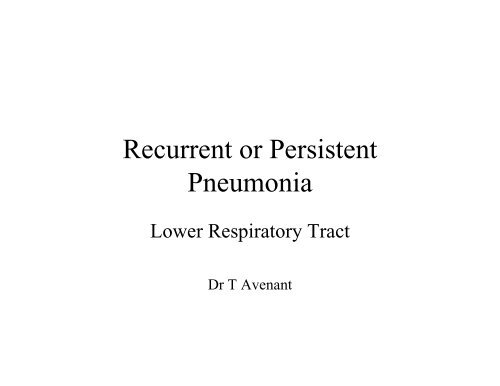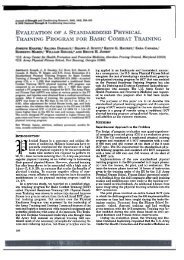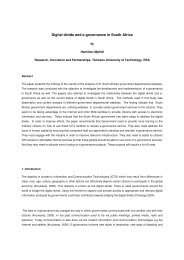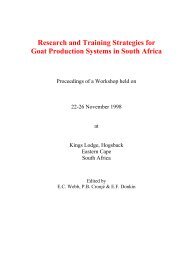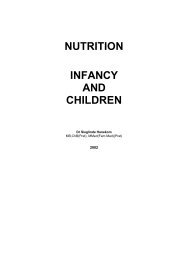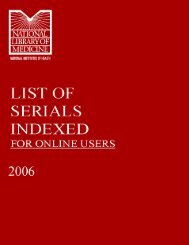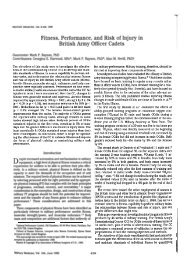Recurrent or Persistent Pneumonia
Recurrent or Persistent Pneumonia
Recurrent or Persistent Pneumonia
You also want an ePaper? Increase the reach of your titles
YUMPU automatically turns print PDFs into web optimized ePapers that Google loves.
<strong>Recurrent</strong> <strong>or</strong> <strong>Persistent</strong><br />
<strong>Pneumonia</strong><br />
Lower Respirat<strong>or</strong>y Tract<br />
Dr T Avenant
• Definitions<br />
<strong>Recurrent</strong> <strong>or</strong> <strong>Persistent</strong><br />
– <strong>Recurrent</strong> pneumonia<br />
• m<strong>or</strong>e than two episodes<br />
of pneumonia in 18<br />
months<br />
– <strong>Persistent</strong> pneumonia<br />
• symptoms that do not<br />
clear within 14 days<br />
• radiograph that do not<br />
revert to n<strong>or</strong>mal within<br />
4-6 weeks<br />
<strong>Pneumonia</strong><br />
• Most common causes<br />
of recurrent<br />
pneumonia<br />
–PTB<br />
– f<strong>or</strong>eign body aspiration<br />
– misdiagnosed <strong>or</strong><br />
inappropriately treated<br />
asthma<br />
–HIV<br />
– bronchiectasis
Approach to recurrent pneumonia<br />
• Localize disease<br />
– Clinical<br />
– X-ray<br />
• Localized disease<br />
– most likely a local abn<strong>or</strong>mality of a bronchus <strong>or</strong> lung<br />
parenchyma<br />
– common causes<br />
• TB (glands)<br />
• f<strong>or</strong>eign body aspiration<br />
• localized bronchiectasis<br />
– bronchoscopy and RT of the lung usually indicated
Approach to recurrent pneumonia<br />
• Widespread disease<br />
– immune compromised group<br />
• acquired (AIDS & NAIDS)<br />
• congenital immunodeficiency syndromes<br />
– non-immune compromised group<br />
• aspiration syndromes<br />
• abn<strong>or</strong>mal cough mechanism<br />
• abn<strong>or</strong>mal mucus clearance<br />
• “fragile lung” after insult
• Narrowed airway<br />
Anatomic localized illness<br />
– Extrinsic compression<br />
• Lymph nodes<br />
– TB, Lymphoma,<br />
Neoplasm<br />
• Vascular ring<br />
– Bronchial wall<br />
• bronchomalasia, web,<br />
stricture<br />
– Endobronchial pathology<br />
– Endobronchial<br />
pathology(continued)<br />
• f<strong>or</strong>eign body, TB<br />
granuloma, neoplasm<br />
• Congenital lung lesions<br />
– Bronchogenic cyst<br />
– Congenital lobar emphysema<br />
– Lung sequestration<br />
• Focal bronchiectasis
Widespread Disease with<br />
Immunodeficiency<br />
• Acquired<br />
– NAIDS<br />
– HIV lung illness<br />
• Bacterial pneumonia, TB,<br />
CMV, PCP<br />
• Other opp<strong>or</strong>tunistic<br />
infections<br />
– Candida albicans<br />
– Cryptococcus<br />
neof<strong>or</strong>mans<br />
• LIP<br />
• Lymphoma / Kaposi<br />
– Immune suppression<br />
• Congenital<br />
– B cell defects<br />
– T cell defects<br />
– Phagocyte defects<br />
– Complement defects<br />
– Combined defects
Widespread Disease with N<strong>or</strong>mal<br />
• Allergy<br />
– Undiagnosed asthma<br />
(mucus plugs)<br />
– Eosinophil pulmonary<br />
infiltrates<br />
• Persisting lung<br />
infection - TB<br />
• <strong>Recurrent</strong> aspiration<br />
– Sucking <strong>or</strong> swallowing<br />
abn<strong>or</strong>malities<br />
– TOF<br />
– GOR<br />
Immunity<br />
• Muco-ciliary clearance<br />
defects<br />
– CF, Immotile cilia<br />
• Heart lesions<br />
– L to R shunting with<br />
increased pulmonary blood<br />
flow<br />
• “Fragile”lung<br />
– BPD, Post necrotizing<br />
pneumonitis<br />
• Interstitial pneumonitis
Approach to the child with<br />
recurrent pneumonia<br />
• Step one<br />
– careful hist<strong>or</strong>y<br />
– clinical evaluation<br />
• Step two<br />
– localize disease<br />
• clinical examination<br />
• CXR<br />
– exclude common causes<br />
• TB w<strong>or</strong>k-up<br />
• f<strong>or</strong>eign body aspiration<br />
• asthma<br />
• HIV<br />
• Step three<br />
– diagnose & treat if possible -<br />
if not<br />
– refer f<strong>or</strong> specialist w<strong>or</strong>k-up&<br />
treatment<br />
• f<strong>or</strong> localized disease<br />
– RT<br />
– bronchoscopy most likely<br />
to be done<br />
• f<strong>or</strong> widespread illness<br />
– further specialist w<strong>or</strong>k-up<br />
depending on situation
Suppurative Lung Disease<br />
Bronchiectasis<br />
Lung Abscess
Bronchiectasis<br />
• Permanent destruction of bronchial walls and lung<br />
tissue due to chronic infection<br />
• Mechanisms<br />
– Bronchial lumen obstruction<br />
• TB glands, f<strong>or</strong>eign body, pertussis<br />
– Parenchymal destruction from necrotizing pneumonia<br />
• Bacteria: staphylococci, Klebsiella, anaerobes, tuberculosis<br />
• Viruses: measles, adenovirus<br />
– Repeated respirat<strong>or</strong>y infections<br />
• Malnourished, cystic fibrosis, generalized<br />
immunodefficiencies, aspiration pneumonia, ciliary diskinesia
• Hist<strong>or</strong>y<br />
Clinical Picture<br />
– Repeated visits <strong>or</strong> admissions with lower<br />
respirat<strong>or</strong>y infections<br />
– Productive cough<br />
• Activity<br />
• Change in position<br />
– Difficult in children<br />
– Haemoptysis rare in children
• Examination<br />
Clinical Picture<br />
– Clubbing after + 1 year<br />
–Halitosis<br />
– Growth retarded<br />
– Wide spread crackles<br />
and wheezes<br />
– Pulmonary<br />
hypertension and c<strong>or</strong><br />
pulmonale
Diagnosis<br />
• Clinical picture<br />
• Chest radiograph<br />
– Non specific <strong>or</strong><br />
– Area of opacification that fails to resolve<br />
– Honey comb appearance (small cysts)<br />
– Widespread destruction, fibrosis and loss of<br />
volume<br />
• Computed tomography
Differential Diagnosis<br />
Evaluate every patient<br />
with bronchiectasis f<strong>or</strong><br />
• Sinusitis<br />
• Ciliary dyskinesis<br />
• Immunodeficiency<br />
• TB<br />
• Asthma<br />
• CF<br />
• If not found,<br />
bronchoscopy f<strong>or</strong><br />
– Stenosis, strictures,<br />
f<strong>or</strong>eign bodies,<br />
tumours<br />
– Bacterial cultures
• Prevention<br />
Treatment<br />
– Immunization<br />
– C<strong>or</strong>rect treatment of pneumonia<br />
– C<strong>or</strong>rect treatment of f<strong>or</strong>eign body inhalation<br />
– Early detection and treatment of TB<br />
• Physiotherapy with postural drainage
Treatment<br />
• Appropriate antibiotics<br />
• Immunized against influenza<br />
• Some benefit from bronchodilat<strong>or</strong>s<br />
• Surgery if<br />
– Disease progression and<br />
– Unilateral<br />
– No pulmonary hypertension<br />
– Adequate lung function
Lung abscess<br />
• Abscesses follow infection with:<br />
– Staphylococcus aureus<br />
– Haemophilus influenza<br />
– Klebsiella pneumoniae<br />
– Mycobacterium tuberculosis<br />
– Anaerobic infections<br />
– Streptococcus pneumoniae (rare)<br />
• In children most often after aspiration of infected<br />
material
• Clinical picture<br />
Lung abscess<br />
– Toxic, malaise<br />
– High swinging fever<br />
– Foul smelling sputum<br />
– Respond po<strong>or</strong>ly to antibiotics<br />
– Amph<strong>or</strong>ic breathing<br />
– CXR: cavity with fluid level
Lung abscess
Treatment<br />
• Postural drainage<br />
• Intravenous antibiotics<br />
– Penicillin<br />
– Cloxacillin<br />
– Aminoglycoside<br />
• Exclude bronchial obstruction<br />
•Drainage


